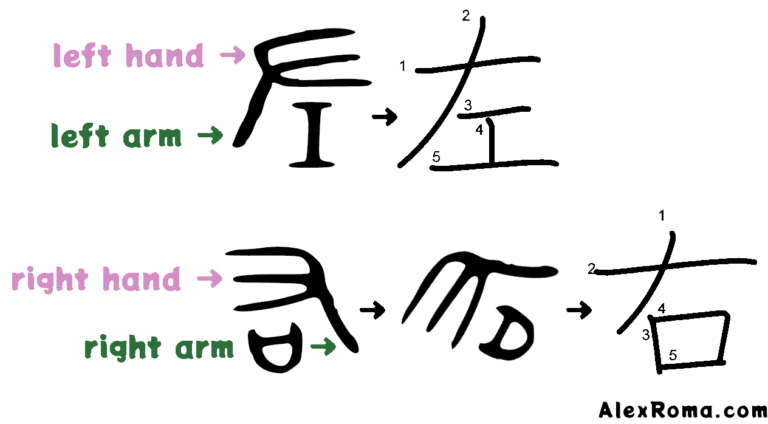Stroke order rule 9 – horizontal vs left sweep: shorter first
This is one of my “weakest” rules, and it is more like a mnemonic trick. Make sure you read this whole section as I included one very useful advice at the end.
Whenever a horizontal stroke and a 左払い hidariharai (described in the previous rule) cross each other, the shorter stroke is written first.

The crossing strokes are highlighted: the first stroke in red, and the second stroke in green. In the kanji 有 aru, 布 nuno and 希 KI, the hidariharai is written first. When compared to the remaining three kanji, 友 tomo, 存 SON and 在 aru, the first (red) stroke is visibly shorter.
Furthermore, the crossing shapes in 有 aru, 布 nuno and 希 KI are more “compressed”, whereas in 友 tomo, 存 SON and 在 aru they are more relaxed.
As a final note on the diagram above, the characters 存 SON and 在 aru present a third vertical stroke intersecting the second (green) stroke. When this stroke is present, the order is always: horizontal, hidariharai, vertical.
Left hand and right hand
This rule is also handy for memorising the stroke order of 左 hidari ‘left’ and 右 migi ‘right’. The crossing shape in these two characters was originally the representation of a hand. One stroke represents the “arm”, and the other stroke the “hand”.

The diagram compares the shapes found in Chinese bronze inscriptions for the characters 左 hidari ‘left’ and 右 migi ‘right’ with the shapes used today. The ancient pictograms show stylised hands and ritualistic objects: 工 KOU and 口 SAI.
- In 左 hidari ‘left’, the hand is the horizontal stroke. The hand is written first, then the arm.
- In 右 migi ‘right’, the hand is the hidariharai stroke. The hand is written first, then the arm.
In both cases the hand is written first.
Always consult a dictionary
The shorter first rule is more of a rule of thumb than a proper stroke order rule. Depending on the font used, discerning which stroke is longer and which shorter may become impossible.
One final advice:
Whenever a horizontal crosses a hidariharai, look up the stroke order using a real dictionary (or Rikaikun one a web browser), then memorise the whole kanji.
This is the only way to eliminate all ambiguity.
